![]()
| Tibet, China | Lhasa | 2001.10.17 - 10.20 |
Capital of Tibet
After driving 5 days overland from Kathmandu through the desolate Tibetan landscape watching people manually till their frozen fields and walk the yaks between valleys, we were startled by the modernity of Lhasa. A suppressed Tibetan culture emanated from the pragmatic Chinese orderliness visible in the compartmentalized concrete shops, straight wide roads, and posted Chinese slogans. The back streets seemed more Tibetan. The boulevards were undoubtedly Chinese.
Finally free of the tour, we consulted our guidebook, the Japanese Chikyu-no-Arukikata, for hotel options. China Tibet Tours put all the 8-day paying clients into the absurdly expensive Flora Hotel that charged US$35 (about ¥280) per double room per night. 10 minutes walk away, we found a nicer room for ¥100.
We were still owed plane tickets from Lhasa to Kathmandu. According to Green Hill, we should have already received them and had them reconfirmed the day before. Concerned about our tickets, we asked the CITS guide. "That's not my responsibility," was his uncommitted reply. The Flora Hotel reception intervened. After a telephone call, they asked us to return tomorrow at 18:30 for the tickets. Deciding that if our tickets weren't ready by tomorrow, we would still have Friday to contact the CITS office, we accepted their proposition.
Thursday, our first full day in Lhasa, was immensely enjoyable. We planned our day with Kirk and Maren. First stop: The Bank of China to use the ATM. On the way, we stopped for a delicious ¥0.5 rice porridge breakfast. Despite what Green Hill and our Lhasa hotel reception told us, there is no ATM in Lhasa. Kirk used his American Express Card to get Chinese Yuan at the best rate possible, then kindly traded us Yuan for US$ cash. All worked out perfectly in the end.
Backtracking towards our hotel, we came to the entrance to Potala Palace, the political and secular center of Tibet until the 14th Dalai Lama was exiled to India in 1959. The palace interior is room after room of Buddha statues and gold, silver, and jeweled burial chambers of previous Dalai Lamas. Prior to the Chinese invasion of Tibet, Potala Palace housed government offices, storerooms, chapels, and a school for young monks destined to become officials. It was also the winter residence of the Dalai Lama.
We were jolted to see signs in English declaring various artifacts in Potala Palace to be Chinese National Treasures. How can China make such a claim after having destroyed 99.7% of the monasteries across Tibet? The beauty within Potala Palace is astounding. Unfortunately interior photographs are prohibited.
Our next visit was to Drepung Monastery. Built in 1416, it once housed 10,000 monks. Now there are only several hundred. Drepung is a massive area that tourists can wander about freely. We were fortunate to witness the monthly gathering of monks for yak-butter tea, bread, and prayer. In the kitchen, yak-butter tea boiled in a huge copper caldron with a one-meter diameter. The oven was a vast wood burning stove. Five-liter wooden buckets were dunked into the tea and handed to child monks who refilled tea cups in the prayer room.
Getting to Drepung Monastery by public bus is simple. Buses in Lhasa follow one of five routes. Each bus has its route number painted on front. There are no designated stops. To board, wave one down. It will stop. The attendant, who shouts for customers and collects bus fare, is extremely helpful. Tell him or her your destination and you will be notified of your stop. Bus fare is ¥2. Bus 3 loops from the center of Lhasa to the Drepung Monastery turn-off. A 30-minute walk up the dirt road takes you to the Drepung entrance.
Returning from Drepung in time for our 18:30 air ticket collection at Flora Hotel was a waste of time. "Not today. Come back at 15:30 tomorrow," we were told. Exasperated, we left.
Day two in Lhasa was as enjoyable as the first. Again accompanied by Kirk and Maren, we walked to Jokhang Temple, where the 14th Dalai Lama was inducted as a novice monk at age 5. Forewarned about long lines to visit each of the internal chapels, we reached the entrance before the 08:30 opening time. Devout Buddhists prayed in front with repeated motion similar to a squat-thrust. Standing upright with praying hands together, they bent forward to lie flat on the ground with hands facedown next to their torso. In the lying position, they extended their hands forward above their head, returned them to their torso, and finally stood upright at the starting position. The young monks repeated this action quickly at exhausting speed. The older people prayed at a more leisurely pace.
Once the doors to Jokhang Temple opened, a disorganized rush of local people sprinted toward the inner chapels. Within minutes, the inside line grew from nothing to a 30-minute wait. Almost all of the locals came to pray at each chapel in a clockwise order. The line of people snaked in and out of each while intermittent tourists jumped in here and there to view only the more interesting chapels. Surprisingly, when we jumped the queue, the locals kindly let us in. With an early arrival, Jokhang Temple can be viewed in its entirety in one hour. A few hours later after the arrival of large tour groups, the visit can take all day.
Our next and final visit was to Sera Monastery. Bus 5 goes from the center of Lhasa to Sera. The fare is ¥2. Structurally and ornamentally, Sera is less interesting than the other sites we saw, but we got the chance to see monks whitewashing the building exteriors. The methods deployed in whitewashing appeared to be the most inefficient possible. A white powder substance, hand carried up a flight of steps, was dumped into a huge vat of water in the upper courtyard. Six monks continually stirred the mixture while another dunked a bucket to fill metal jugs that looked like western milk jugs. Each jug was strapped onto a porter's back and carried to the building being whitewashed. During the transport, milky white liquid sloshed out of the jug onto the porter. The remaining liquid was dumped into a large bucket in front of the building that monks were whitewashing by filling a bowl with the liquid and tossing the whitewash in the air in an attempt to color a particular section of the wall. 90% of the whitewash flew into open windows, hit dirt and weeds, or fell back to the walkway. An occasional targeted throw would lightly stain a section of wall. 10 more hits in the same place and the wall might turn white. Watching in disbelief, we decided the whitewashing methods deployed today hadn't changed from times when 5000 idle monks were looking for something to do.
Back at the Flora Hotel at 15:30, we saw our inept guide. "No tickets. Come back at 18:30," he said. Now we were getting angry. With only two days in Lhasa, CITS was wasting our precious time. We demanded that the guide take responsibility. The more we pressured, the more arrogant and abusive he became. A shouting match in the hotel lobby erupted and led to the guide threatening to punch us as the hotel staff restrained him from behind and led him out the rear door. "Incompetent"? "Unruly"? "Unprofessional"? We uttered some harsher descriptives as we angrily departed.
At 18:30, the CITS man with everyone's plane and bus tickets arrived. One problem: Some of the non-refundable, non-exchangeable tickets were issued in names of people who earlier booked, then cancelled their Tibet Tour. "No problem," CITS claimed as Wes was told to become Mr. Baker and Masami became Mrs. Letner. To say that CITS is poor quality is an understatement.
The next morning at the Lhasa Airport, our bags were checked, we were x-rayed twice, our tickets were checked, and we miraculously received boarding passes. Through the entire security process, nobody verified that the names in our passports matched the names on our tickets. Once on the plane, we were relieved to be free of CITS.
Flying from Lhasa to Kathmandu is stunning. For the first 40 minutes the plane flies over snowcapped mountains below, no different than flying over the Rockies or Alps. But then the monster mountain Everest comes into view. The Everest summit and the airplane are at the same elevation. We could look straight across to view the mountain. Looking any other direction, we could only see clouds and other mountain tops far, far below. The experience was exhilarating. We had the view from the top of Everest without the month-long danger of climbing it.
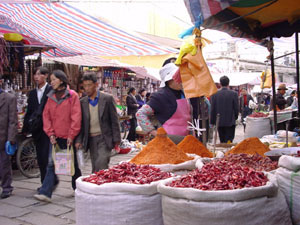 |
Chili peppers and other spices are sold along the walkway at Barkhor Market in the center of the Tibetan section of Lhasa. |
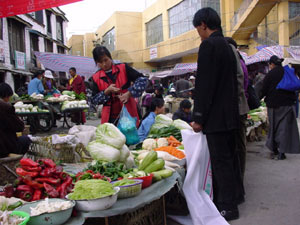 |
Numerous fresh vegetable and fruit stands occupy the main road through Barkhor Market. |
 |
Nearly every building exterior and hotel room interior has detailed painting painstakingly drawn by hand. |
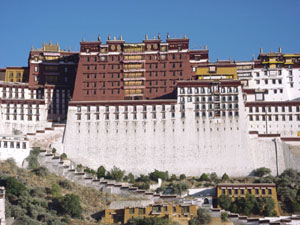 |
The enormous Potala Palace, that at one time was the cultural and spiritual center of Tibet, stands high within Lhasa city center. |
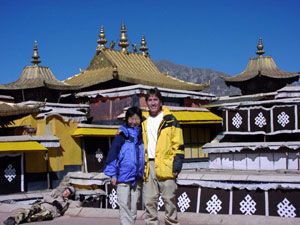 |
On the roof of Potala Palace we view the surrounding mountains and look down upon Lhasa. |
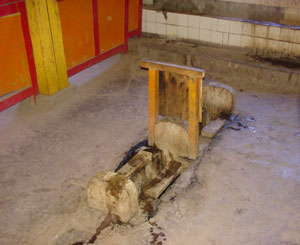 |
The public toilets in Tibet are a bit different than one would expect in the West. There's no privacy, just two holes with covers and a tiny partition between you and your neighbor. |
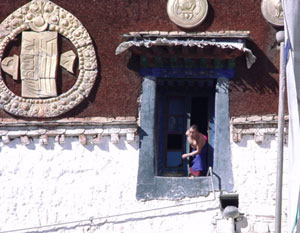 |
A monk leans out an upper window at Drepung Monastery. |
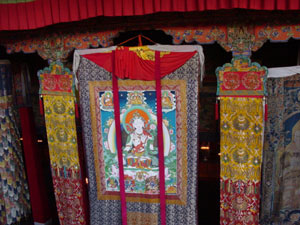 |
Within each monastery hang minutely stitched colorful silk tapestries. Most are several decameters in length. |
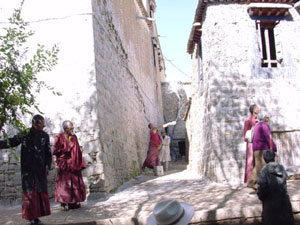 |
A monk tosses a bowl of whitewash onto an exterior wall at Sera Monastery. |
Copyright © 2000-2002 Wes and Masami Heiser. All rights reserved.